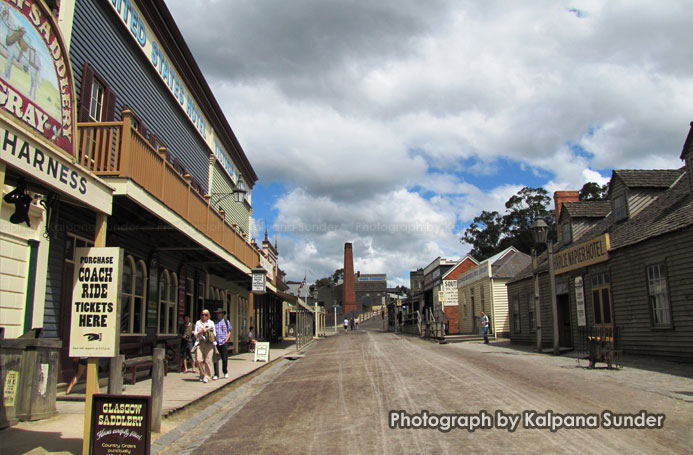
It's a step back in time. Women walk in voluminous period costumes, twirling pretty parasols, on Main Street with its dusty timbered buildings. Chestnut Clydesdale horses and stagecoaches clip-clop with passengers, quaint shops sell herbal soaps, aromatic spices as well as delicate Victorian lace. Even the sounds that you hear hark back to the days of yore – the horses' hooves, the sound of anvil and hammer and the cries of soldiers. We are in Sovereign Hill, in the town of Ballarat. Sovereign Hill is a gold rush town re-created on 25 hectares of the richest alluvial fields, an hour and a half drive from Melbourne, Australia.
It all began in the year 1851. John Dunlop and James Regan panned a few ounces of gold at Poverty Point in Ballarat. And set in motion one of the biggest gold rushes in history. Ships' crews deserted and headed inland in droves. Fathers left their families to dig for gold, and whole families travelled from the city to set up camp on the goldfields... people from more than 20 countries around the world rushed to the goldfields; today one in every four Australians can trace his origins to the goldfields!
In 1891 Mark Twain arrived at Ballarat's grand railway station and wrote about the town in his book ‘Following the Equator'. Ballarat in the aboriginal language means ‘resting or camping place'. Today its wide boulevards lined with elm trees and grand bluestone and brick buildings, remind visitors of its glorious history. Ballarat was a 19 century boomtown. There were 1,000 prospectors within two years and in 1853 alone they say that 9,926 kilograms of gold was sent to Melbourne! It was also home to Australia's most popular symbol of liberty – the blue Eureka Flag with its white Southern Cross.
Main Street has the buzz, the colour and the heady excitement of the gold fever: Shops sell boiled lollies, liquorice, fudge, mustard and jams. There are bridles and saddles' spurs, crops, even leather hats and wallets at Glasgow Saddlery. Our guide tells us that there are more than fifty working horses in Sovereign Hill and they have to be shod – there is a blacksmith making iron ware in a simple forge. I walk in to an apothecary selling exotic pot pourri, handmade soaps, mysterious powders and herbal infusions. The Ballarat Times shop is where you can get personalised ‘Wanted' posters, bills and notices made. There are the Red Hills Photographic Rooms where we see a queue of people waiting to walk in to the sepia age in period costumes and jewellery.
Red Hilly Gully Creek is a stream surrounded by small miners' tents, where excited children and adults squeal to each other,” Yippee, we are rich!” There are tour groups crouching down and getting dirty near the steam, sloshing pans of gravel and sand! It's of course thoughtfully salted with fine specks of gold by the management, and the rule here is ‘finders, keepers'! The crowd puller is however the ‘Gold Pour', a show where a master smithy shows us how gold is transformed in to a glittering ingot. Wearing an apron and protective glasses, he peers into a crucible with molten metal at 1,200 degree centigrade and with a long pincers pours it in to a mould. With the élan of a magician he plunges it in to a trough of cold water and as it sizzles and steams, declares, “Ladies and Gentlemen, this is 99.9% pure gold. Do you want to hold it?” he asks me. I gingerly cradle the small fortune in my nervous hands.
Walking around Sovereign Hill, we learn about the life of the miners. Intertwined with the lure of the yellow metal are stories of greed, gambling, poverty and violence. Many miners got rich but died early in mining accidents or lung diseases. For two years after the gold was discovered, there were no liquor licenses granted: one can imagine tired miners who could not get a decent drink and created sly shanties where they could drown their sorrows.
One drink that was popular was the blow-me-skull-off, a dynamite combination with spirits, cayenne pepper, opium and rum. By 1868, when the population had swelled to 60,000, liquor was finally available. Our guide tells us about the sultry Lola Montez, a singer from Ireland whose dalliance with writer Dumas, King Ludwig of Bavaria and music composer Liszt was legendary. She entranced and shocked the local population with her erotic ‘spider dance' at the local theatre when she visited Ballarat.
The people of Ballarat always enjoyed culture and talent. In 1885 a soprano from Melbourne visited Ballarat and performed in the local theatre. The people were entranced by her incredible voice… Have you heard of Peach Melba and Melba toast? The soprano was Dame Nellie Melba after whom these were named!
You can finish the day by watching the Blood on the Southern Cross, a nightly million dollar sound and light show enacting the famous Eureka Rebellion, when the miners rebelled against repression and sowed the seeds of democracy. We finish our ‘golden' day watching the Red Coat Soldiers in a ceremonial parade, escorting the gold from the bank vaults to Melbourne. It's not very often that you get to spend a day in a time capsule. Sovereign Hill does transport you to a different era.
Published in the Hindu Metro Plus, January, 2012.

